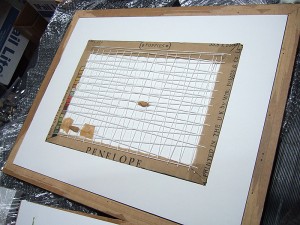 I recently had a tapestry frame that I had produced for a customer a few years ago back in the framing workshop for the replacement of the existing front mount board with an new lighter cream coloured one. The process allowed me to re-examine and photograph my previous work for inclusion and discussion in this article.
I recently had a tapestry frame that I had produced for a customer a few years ago back in the framing workshop for the replacement of the existing front mount board with an new lighter cream coloured one. The process allowed me to re-examine and photograph my previous work for inclusion and discussion in this article.
Needlework or stitched artwork is created on a variety of substrate materials, ranging from thick holed loose weaved canvas, to narrow weaved canvas, to cotton or finer more densely packed textiles. There are also some needleworks that have no substrate like laces, and these require different mounting techniques to other stitched works.

Mounting needlework
To mount and frame most needlework created on a textile or meshed canvas substrate (like tapestries or cross-stitching), stretching of the fabric is required over a rigid material in order to flatten it’s surface (remove wrinkles, and distortions) and make it more presentable as a piece of artwork.
Some framing businesses can refuse to do needlework mounting and framing because of the extra time involved in the process of stretching. A needlework framing job can take an hour or more of extra time (plus extra materials) to complete compared to a regular paper based artwork framing job. As a result, the framer has to take this into account in the frame price, which in turn can lead to quite expensive framing jobs for the owner!

Stretching the needlework
One method of stretching the needlework is to stretch it over a 5mm thick piece of white conservation foam board. The white foam board face will ensure that the stitch work looks bright and clear (especially if it is a slightly transparent white material). The 5mm thickness of the foam board is enough to provide suitable rigidity for the stretching process.
The needlework has to be pinned down into position, and then laced similarly to shoe laces but in both horizontal and vertical directions. The ends are tied away and it should resemble a criss-cross laced pattern on the back as shown in the image on the right. The choice of lacing should be suitable for the material being stretched. In this case a thicker cord has been used as there are wide holes in the tapestries open weave canvas substrate.

The mount
The mount used for surrounding a needlework, should have a foam board surround on its back side, shaped to fit the stretched and laced needlework. The mount bevel edge is sized to overlap the foam board so it is not seen. It also should hide the rougher edges of the stretched tapestry artwork. The mount itself is a triple mount which keeps the raised texture of the tapestry off of the glass surface.

Finishing the frame
Once the needlework has been stretched, it can then be placed into the mount and will look like the image on the right. There should be no slack between the stretched needlework and the surrounding foam board. This will prevent the stretched needlework from moving within the mount. It’s now time to replace the backing board and finish the frame off.

The frame back is completed with backing tape, several canvas offset clamps (as the thick mount is deeper than the frame rebate), D-Rings, felt pads and low stretch picture cord.
The finished frame front is shown in the first picture in this article.
